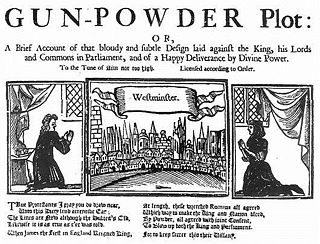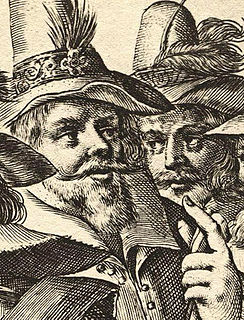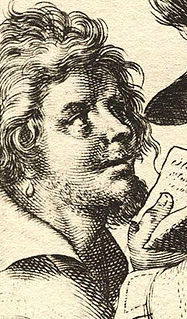
Guy Fawkes, also known as Guido Fawkes while fighting for the Spanish, was a member of a group of provincial English Catholics involved in the failed Gunpowder Plot of 1605. He was born and educated in York; his father died when Fawkes was eight years old, after which his mother married a recusant Catholic.

The Gunpowder Plot of 1605, in earlier centuries often called the Gunpowder Treason Plot or the Jesuit Treason, was a failed assassination attempt against King James I by a group of provincial English Catholics led by Robert Catesby who sought to restore the Catholic monarchy to England after decades of persecution against Catholics.

Robert Catesby was the leader of a group of English Catholics who planned the failed Gunpowder Plot of 1605.

Henry Garnet, SJ, sometimes Henry Garnett, was an English Jesuit priest executed for his complicity in the Gunpowder Plot of 1605. Born in Heanor, Derbyshire, he was educated in Nottingham and later at Winchester College before he moved to London in 1571 to work for a publisher. There he professed an interest in legal studies and in 1575, he travelled to the continent and joined the Society of Jesus. He was ordained in Rome some time around 1582.
Francis Tresham, eldest son of Thomas Tresham and Muriel Throckmorton, was a member of the group of English provincial Catholics who planned the failed Gunpowder Plot of 1605, a conspiracy to assassinate King James I of England.

William Parker, 13th Baron Morley, 4th Baron Monteagle, was an English peer, best known for his role in the discovery of the Gunpowder Plot. In 1605 Parker was due to attend the opening of Parliament. He was a member of the House of Lords as Lord Monteagle, the title on his mother's side. He received a letter; it appears that someone, presumably a fellow Catholic, was afraid he would be blown up. The so-called Monteagle letter survives in the National Archives, but its origin remains mysterious.

Henry Percy, 9th Earl of Northumberland, KG was an English nobleman. He was a grandee and one of the wealthiest peers of the court of Elizabeth I. Under James I, Northumberland was a long-term prisoner in the Tower of London, due to the suspicion that he was complicit in the Gunpowder Plot. He is known for the circles he moved in as well as for his own achievements. He acquired the sobriquet The Wizard Earl, from his scientific and alchemical experiments, his passion for cartography, and his large library.

Robert Wintour and Thomas Wintour, also spelt Winter, were members of the Gunpowder Plot, a failed conspiracy to assassinate King James I. Brothers, they were related to other conspirators, such as their cousin, Robert Catesby, and a half-brother, John Wintour, also joined them following the plot's failure. Thomas was an intelligent and educated man, fluent in several languages and trained as a lawyer, but chose instead to become a soldier, fighting for England in the Low Countries, France, and possibly in Central Europe. By 1600, however, he changed his mind and became a fervent Catholic. On several occasions he travelled to the continent and entreated Spain on behalf of England's oppressed Catholics, and suggested that with Spanish support a Catholic rebellion was likely.

Ambrose Rookwood was a member of the failed 1605 Gunpowder Plot, a conspiracy to replace the Protestant King James I with a Catholic sovereign. Rookwood was born into a wealthy family of Catholic recusants, and educated by Jesuits in Flanders. His older brother became a Franciscan, and his two younger brothers were ordained as Catholic priests. Rookwood became a horse-breeder. He married the Catholic Elizabeth Tyrwhitt, and had at least two sons.

Sir Everard Digby was a member of the group of provincial English Catholics who planned the failed Gunpowder Plot of 1605. Although he was raised in a Protestant household, and married a Protestant, Digby and his wife were converted to Catholicism by the Jesuit priest John Gerard. In the autumn of 1605, he was part of a Catholic pilgrimage to the shrine of St Winefride's Well in Holywell. About this time, he met Robert Catesby, a religious fanatic who planned to blow up the House of Lords with gunpowder, killing James I. Catesby then planned to incite a popular revolt, during which a Catholic monarch would be restored to the English throne.

Thomas Percy was a member of the group of provincial English Catholics who planned the failed Gunpowder Plot of 1605. A tall, physically impressive man, little is known of his early life beyond his matriculation in 1579 at the University of Cambridge, and his marriage in 1591 to Martha Wright. In 1596 his second cousin once removed, Henry Percy, 9th Earl of Northumberland, appointed him constable of Alnwick Castle and made him responsible for the Percy family's northern estates. He served the earl in the Low Countries in about 1600–1601, and in the years before 1603 was his intermediary in a series of confidential communications with King James VI of Scotland.

The Gunpowder Plot: Exploding the Legend was a British television show, hosted by Richard Hammond that recreated elements of the Gunpowder Plot in which Guy Fawkes attempted to blow up the House of Lords.

John (Jack) Wright, and Christopher (Kit) Wright, were members of the group of provincial English Catholics who planned the failed Gunpowder Plot of 1605, a conspiracy to assassinate King James I by blowing up the House of Lords. Their sister married another plotter, Thomas Percy. Educated at the same school in York, the Wrights had early links with Guy Fawkes, the man left in charge of the explosives stored in the undercroft beneath the House of Lords. As known recusants the brothers were on several occasions arrested for reasons of national security. Both were also members of the Earl of Essex's rebellion of 1601.
Oswald Tesimond was an English Jesuit born in either Northumberland or York who, while not a direct conspirator, had some knowledge of the Gunpowder Plot beforehand.

Thomas Bates was a member of the group of provincial English Catholics who planned the failed Gunpowder Plot of 1605.

John Grant was a member of the failed Gunpowder Plot, a conspiracy to replace the Protestant King James I of England with a Catholic monarch. Grant was born around 1570, and lived at Norbrook in Warwickshire. He married the sister of another plotter, Thomas Wintour. Grant was enlisted by Robert Catesby, a religious zealot who had grown so impatient with James's lack of toleration for Catholics that he planned to kill him, by blowing up the House of Lords with gunpowder. Grant's role in the conspiracy was to provide supplies for a planned Midlands uprising, during which James's daughter, Princess Elizabeth, would be captured. However, on the eve of the planned explosion, Guy Fawkes was discovered guarding the explosives the plotters had positioned in the undercroft beneath the House of Lords, and arrested.

Edward Oldcorne alias Hall was an English Jesuit priest. He was known to people who knew of the Gunpowder Plot to destroy the Parliament of England and kill King James I; and although his involvement is unclear, he was caught up in the subsequent investigation. He is a Roman Catholic martyr, and was beatified in 1929.

The Gunpowder Plot was a failed assassination attempt against King James VI of Scotland and I of England by a group of provincial English Catholics led by Robert Catesby. The conspirators' aim was to blow up the House of Lords at the State Opening of Parliament on 5 November 1605, while the king and many other important members of the aristocracy and nobility were inside. The conspirator who became most closely associated with the plot in the popular imagination was Guy Fawkes, who had been assigned the task of lighting the fuse to the explosives.
Sir Richard Walsh was an English politician who served as High Sheriff of Worcestershire and is noted for his role in defeating Robert Catesby's remaining followers at Holbeche House following the failure of the Gunpowder Plot. He came from Shelsley Walsh.
Stephen Littleton, , was an Englishman executed for his involvement in the Gunpowder Plot.
















